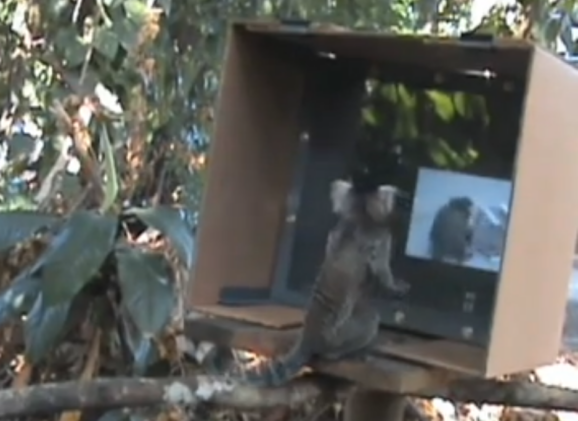Monkeys Learn From Movies
This article is more than 2 years old
 No matter how much we try to resist, humans learn from movies and television. What we learn is another question, though I’ve certainly learned quite a bit from Julia Child and Top Chef. As it turns out, we’re not the only ones who learn from what we see in films — wild marmosets do too. Monkey see, monkey do, as they say.
No matter how much we try to resist, humans learn from movies and television. What we learn is another question, though I’ve certainly learned quite a bit from Julia Child and Top Chef. As it turns out, we’re not the only ones who learn from what we see in films — wild marmosets do too. Monkey see, monkey do, as they say.
University of Vienna researcher Tina Gunhold has been studying and conducting experimental research with a bunch of different animals, particularly when it comes to traditions and social learning. Studies such as the dog and wolf social learning project, which found that wolves are much better at learning from each other than dogs are, is precisely the kind of thing Gunhold is interested in. She also happens to run the University’s marmoset laboratory. Gunhold wondered whether wild marmosets would be affected by what they saw on the screen — in particular, by an instructional video featuring another marmoset liberating a treat from a device. She wondered whether the video could actually teach other marmosets how to get a treat from the same device.
Gunhold and her colleagues brought the device and a small movie screen to a forest in Brazil, where they screened it for wild marmosets. I don’t think she brought them popcorn, but they didn’t seem to mind. Marmosets were an interesting choice for the experiment because marmosets are particularly territorial, so the researchers weren’t sure how they’d interpret the virtual presence — would they consider it an outsider and attack? Would they run away? Or would there be some recognition and ability to learn from the on-screen monkey?
Turns out, the marmosets were enticed by the video box — especially the young ones. And they learned from what they saw: after watching the video, they were able to get the treat from the device, especially when compared to a still image of a marmoset on the screen. The monkeys learned how to complete the task one by one, which makes it difficult to know whether the subsequent monkeys were learning from the video or from the other monkeys — probably both, according to the researchers.
In the future, Gunhold would like to alter the study to see whether it matters that the monkey on-screen is a dominant or subordinate member of a family, though that would require filming specific marmosets from a given location. She wants to see how traditions of social and familial learning are formed, and believes that the video box set-up would allow for that for a number of different animal species.
The researchers somehow resisted showing a jewel heist movie to the marmosets.












